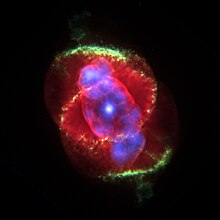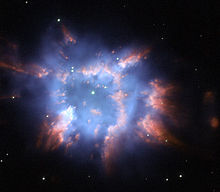Tinh vân hành tinh
Tinh vân hành tinh hay đám mây hành tinh là một loại tinh vân phát quang chứa lớp vỏ khí ion hóa phát sáng sinh ra từ những sao khổng lồ đỏ trong giai đoạn cuối của chúng.[2] Đây là một hiện tượng tương đối ngắn ngủi, chỉ diễn ra vài chục ngàn năm, so với tuổi đời thông thường hàng tỉ năm của một ngôi sao.


Khác với tinh vân thông thường hình thành nên sao, thuật ngữ planetary nebulae do nhà thiên văn William Herschel đặt ra vào những năm 1780 là một cách đặt tên sai do hiểu nhầm; thực sự thì tinh vân hành tinh không tạo nên hành tinh nào cả. Khi Herschel, một trong những người đầu tiên quan sát những vật thể này qua kính thiên văn, ông thấy chúng có những dạng gần tròn như các hành tinh. Thuật ngữ này tồn tại phổ biến tới ngày nay và các nhà thiên văn cũng không chọn một tên thích hợp hơn để thay thế.[3][4] Từ nebulae mượn từ tiếng Latin có nghĩa là đám mây hoặc sương mù, do đó planetary nebulae nên được hiểu là đám mây hành tinh. Tuy nhiên trong tiếng Việt, nebulae dịch thành tinh vân nên theo đó, nhiều người chọn dịch thuật ngữ thành tinh vân hành tinh, càng thêm sai với nghĩa gốc.
Xem thêm
sửaChú thích
sửaTham khảo
sửa- Lỗi Lua trong Mô_đun:Citation/CS1/Utilities tại dòng 76: bad argument #1 to 'message.newRawMessage' (string expected, got nil).
- Allison, Mark (2006), Star clusters and how to observe them, Birkhäuser, tr. 56–8, ISBN 978-1-84628-190-7
- Bowen, I. S. (tháng 10 năm 1927), “The Origin of the Chief Nebular Lines”, Publications of the Astronomical Society of the Pacific, 39: 295–7, Bibcode:1927PASP...39..295B, doi:10.1086/123745
- Frankowski, Adam; Soker, Noam (tháng 11 năm 2009), “Very late thermal pulses influenced by accretion in planetary nebulae”, New Astronomy, 14 (8): 654–8, arXiv:0903.3364, Bibcode:2009NewA...14..654F, doi:10.1016/j.newast.2009.03.006,
A planetary nebula (PN) is an expanding ionized circumstellar cloud that was ejected during the asymptotic giant branch (AGB) phase of the stellar progenitor.
- Gurzadyan, Grigor A. (1997), The Physics and dynamics of planetary nebulae, Springer, ISBN 978-3-540-60965-0
- Harpaz, Amos (1994), Stellar Evolution, A K Peters, Ltd., ISBN 978-1-56881-012-6
- Hora, Joseph L.; Latter, William B.; Allen, Lori E.; Marengo, Massimo; Deutsch, Lynne K.; Pipher, Judith L. (tháng 9 năm 2004), “Infrared Array Camera (IRAC) Observations of Planetary Nebulae”, Astrophysical Journal Supplement Series, 154 (1): 296–301, Bibcode:2004ApJS..154..296H, doi:10.1086/422820
- Hubble Witnesses the Final Blaze of Glory of Sun-Like Stars, Hubblesite.org, ngày 17 tháng 12 năm 1997, truy cập ngày 9 tháng 8 năm 2008
- Huggins, W.; Miller, W. A. (1864), “On the Spectra of some of the Nebulae”, Philosophical Transactions of the Royal Society of London, 154: 437–44, Bibcode:1864RSPT..154..437H, doi:10.1098/rstl.1864.0013
- Iliadis, Christian (2007), Nuclear physics of stars. Physics textbook, Wiley-VCH, tr. 18, 439–42, ISBN 978-3-527-40602-9
- Jacoby, George. H.; Ferland, Gary. J.; Korista, Kirk T. (2001), “The Planetary Nebula A39: An Observational Benchmark for Numerical Modeling of Photoionized Plasmas”, The Astrophysical Journal, 560 (1): 272–86, Bibcode:2001ApJ...560..272J, doi:10.1086/322489
- Jordan, S.; Werner, K.; O'Toole, S. J. (tháng 3 năm 2005), “Discovery of magnetic fields in central stars of planetary nebulae”, Astronomy & Astrophysics, 432 (1): 273–9, arXiv:astro-ph/0501040, Bibcode:2005A&A...432..273J, doi:10.1051/0004-6361:20041993
- Kiss, L. L.; Szabó, Gy. M.; Balog, Z.; Parker, Q. A.; Frew, D. J. (tháng 11 năm 2008), “AAOmega radial velocities rule out current membership of the planetary nebula NGC 2438 in the open cluster M46”, Monthly Notices of the Royal Astronomical Society, 391 (1): 399–404, arXiv:0809.0327, Bibcode:2008MNRAS.391..399K, doi:10.1111/j.1365-2966.2008.13899.x
- Krause, Arthur (1961), Astronomy, Oliver and Boyd, tr. 187
- Kwok, Sun (2000), The origin and evolution of planetary nebulae, Cambridge University Press, ISBN 0-521-62313-8 (Chapter 1 can be downloaded here.)
- Kwok, Sun (tháng 6 năm 2005), “Planetary Nebulae: New Challenges in the 21st Century”, Journal of the Korean Astronomical Society, 38 (2): 271–8, Bibcode:2005JKAS...38..271K, doi:10.5303/JKAS.2005.38.2.271
- Kwok, Sun; Su, Kate Y. L. (tháng 12 năm 2005), “Discovery of Multiple Coaxial Rings in the Quadrupolar Planetary Nebula NGC 6881”, The Astrophysical Journal, 635 (1): L49–52, Bibcode:2005ApJ...635L..49K, doi:10.1086/499332,
We report the discovery of multiple two-dimensional rings in the quadrupolar planetary nebula NGC 6881. As many as four pairs of rings are seen in the bipolar lobes, and three rings are seen in the central torus. While the rings in the lobes have the same axis as one pair of the bipolar lobes, the inner rings are aligned with the other pair. The two pairs of bipolar lobes are likely to be carved out by two separate high-velocity outflows from the circumstellar material left over from the asymptotic giant branch (AGB) wind. The two-dimensional rings could be the results of dynamical instabilities or the consequence of a fast outflow interacting with remnants of discrete AGB circumstellar shells.
- Kwok, Sun; Koning, Nico; Huang, Hsiu-Hui; Churchwell, Edward (2006), Barlow, Michael J.; Méndez (biên tập), “Planetary nebulae in the GLIMPSE survey”, Proceedings of the International Astronomical Union, Symposium #234, Planetary Nebulae in our Galaxy and Beyond, Cambridge: Cambridge University Press, 2 (S234): 445–6, Bibcode:2006IAUS..234..445K, doi:10.1017/S1743921306003668,
Planetary nebulae (PNs) have high dust content and radiate strongly in the infrared. For young PNs, the dust component accounts for ∼1/3 of the total energy output of the nebulae (Zhang & Kwok 1991). The typical color temperatures of PNs are between 100 and 200 K, and at λ >5 μm, dust begins to dominate over bound-free emission from the ionized component. Although PNs are traditionally discovered through examination of photographic plates or Hα surveys, PNs can also be identified in infrared surveys by searching for red objects with a rising spectrum between 4–10 μm.
|editor3-first=thiếu|editor3-last=(trợ giúp) - Liu, X.-W.; Storey, P. J.; Barlow, M. J.; Danziger, I. J.; Cohen, M.; Bryce, M. (tháng 3 năm 2000), “NGC 6153: a super–metal–rich planetary nebula?”, Monthly Notices of the Royal Astronomical Society, 312 (3): 585–628, Bibcode:2000MNRAS.312..585L, doi:10.1046/j.1365-8711.2000.03167.x
- Maciel, W. J.; Costa, R. D. D.; Idiart, T. E. P. (tháng 10 năm 2009), “Planetary nebulae and the chemical evolution of the Magellanic Clouds”, Revista Mexicana de Astronomía y Astrofísica, 45: 127–37, arXiv:0904.2549, Bibcode:2009RMxAA..45..127M,
These objects are produced by low and intermediate mass stars, with main sequence masses roughly between 0.8 and 8 M⊙, and present a reasonably large age and metallicity spread.
- Majaess, D. J.; Turner, D.; Lane, D. (tháng 12 năm 2007), “In Search of Possible Associations between Planetary Nebulae and Open Clusters”, Publications of the Astronomical Society of the Pacific, 119 (862): 1349–60, arXiv:0710.2900, Bibcode:2007PASP..119.1349M, doi:10.1086/524414
- Marochnik, L.S.; Shukurov, Anwar; Yastrzhembsky, Igor (1996), “Chapter 19: Chemical abundances”, The Milky Way galaxy, Taylor & Francis, tr. 6–10, ISBN 978-2-88124-931-0
- Mermilliod, J.-C.; Clariá, J. J.; Andersen, J.; Piatti, A. E.; Mayor, M. (tháng 8 năm 2001), “Red giants in open clusters. IX. NGC 2324, 2818, 3960 and 6259”, Astronomy and Astrophysics, 375 (1): 30–9, Bibcode:2001A&A...375...30M, doi:10.1051/0004-6361:20010845
- Miszalski, B.; Jones, D.; Rodríguez-Gil, P.; Boffin, H. M. J.; Corradi, R. L. M.; Santander-García, M. (2011), “Discovery of close binary central stars in the planetary nebulae NGC 6326 and NGC 6778”, Astronomy and Astrophysics, 531: A158, arXiv:1105.5731, Bibcode:2011A&A...531A.158M, doi:10.1051/0004-6361/201117084
- Moore, S. L. (tháng 10 năm 2007), “Observing the Cat's Eye Nebula”, Journal of the British Astronomical Association, 117 (5): 279–80, Bibcode:2007JBAA..117R.279M
- Morris, M. (1990), “Bipolar asymmetry in the mass outflows of stars in transition”, trong Mennessier, M.O.; Omont, Alain (biên tập), From Miras to planetary nebulae: which path for stellar evolution?, Montpellier, France, September 4–7, 1989 IAP astrophysics meeting: Atlantica Séguier Frontières, tr. 526–30, ISBN 978-2-86332-077-8Quản lý CS1: nhiều tên: danh sách biên tập viên (liên kết) Quản lý CS1: địa điểm (liên kết)
- Osterbrock, Donald E.; Ferland, G. J. (2005), Ferland, G. J. (biên tập), Astrophysics of gaseous nebulae and active galactic nuclei, University Science Books, ISBN 978-1-891389-34-4
- Parker, Quentin A.; Acker, A.; Frew, D. J.; Hartley, M.; Peyaud, A. E. J.; Ochsenbein, F.; Phillipps, S.; Russeil, D.; Beaulieu, S. F.; Cohen, M.; Köppen, J.; Miszalski, B.; Morgan, D. H.; Morris, R. A. H.; Pierce, M. J.; Vaughan, A. E. (tháng 11 năm 2006), “The Macquarie/AAO/Strasbourg Hα Planetary Nebula Catalogue: MASH”, Monthly Notices of the Royal Astronomical Society, 373 (1): 79–94, Bibcode:2006MNRAS.373...79P, doi:10.1111/j.1365-2966.2006.10950.xQuản lý CS1: nhiều tên: danh sách tác giả (liên kết)
- Parker, Quentin A.; Frew, David J.; Miszalski, B.; Kovacevic, Anna V.; Frinchaboy, Peter.; Dobbie, Paul D.; Köppen, J. (tháng 5 năm 2011), “PHR 1315–6555: A bipolar planetary nebula in the compact Hyades-age open cluster ESO 96-SC04”, Monthly Notices of the Royal Astronomical Society, 413 (3): 1835–1844, arXiv:1101.3814, Bibcode:2011MNRAS.413.1835P, doi:10.1111/j.1365-2966.2011.18259.x
- Reed, Darren S.; Balick, Bruce; Hajian, Arsen R.; Klayton, Tracy L.; Giovanardi, Stefano; Casertano, Stefano; Panagia, Nino; Terzian, Yervant (tháng 11 năm 1999), “Hubble Space Telescope Measurements of the Expansion of NGC 6543: Parallax Distance and Nebular Evolution”, Astronomical Journal, 118 (5): 2430–41, arXiv:astro-ph/9907313, Bibcode:1999AJ....118.2430R, doi:10.1086/301091
- Renzini, A. (1987), S. Torres-Peimbert (biên tập), “Thermal pulses and the formation of planetary nebula shells”, Proceedings of the 131st symposium of the IAU, 131: 391–400, Bibcode:1989IAUS..131..391R
- Soker, Noam (tháng 2 năm 2002), “Why every bipolar planetary nebula is 'unique'”, Monthly Notices of the Royal Astronomical Society, 330 (2): 481–6, arXiv:astro-ph/0107554, Bibcode:2002MNRAS.330..481S, doi:10.1046/j.1365-8711.2002.05105.x
- The first detection of magnetic fields in the central stars of four planetary nebulae, SpaceDaily Express, ngày 6 tháng 1 năm 2005, truy cập ngày 18 tháng 10 năm 2009,
Source: Journal Astronomy & Astrophysics
- Rees, B.; Zijlstra, A.A. (tháng 7 năm 2013), “Alignment of the Angular Momentum Vectors of Planetary Nebulae in the Galactic Bulge” (PDF), Mon. Not. R. Astron. Soc, SpaceTelescope.org
- Planetary Nebulae, SEDS, ngày 9 tháng 9 năm 2013, truy cập ngày 10 tháng 11 năm 2013
Liên kết ngoài
sửa| Wikimedia Commons có thêm hình ảnh và phương tiện truyền tải về Tinh vân hành tinh. |
- Entry in the Encyclopedia of Astrobiology, Astronomy, and Spaceflight
- Press release on recent observations of the Cat's Eye Nebula
- Planetary Nebulae, SEDS Messier Pages
- The first detection of magnetic fields in the central stars of four planetary nebulae
- Planetary Nebulae—Information and amateur observations
- Planetary nebula on arxiv.org